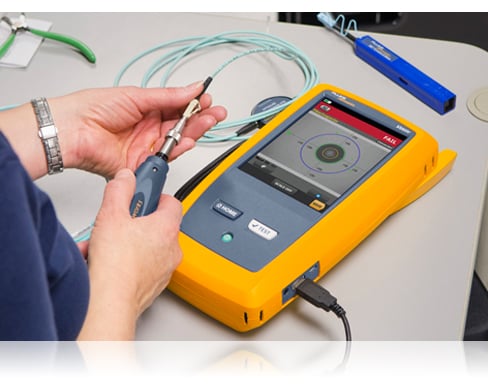Checking Out the Perks of Optical Fibre Examining for Improved Communication Systems
The relevance of optical fibre testing in modern communication systems can not be overstated, as it offers as a foundation for guaranteeing network dependability and performance. This positive screening approach has profound implications for signal quality and functional efficiency, elevating the inquiry of just how these techniques contribute to long-term sustainability in an ever-evolving technological landscape.
Relevance of Optical Fibre Testing
The value of optical fiber testing can not be overemphasized in today's data-driven setting. As companies increasingly count on high-speed information transmission for everyday procedures, the honesty and performance of optical fiber networks are critical. Examining ensures that these networks can support the large amounts of data produced and sent flawlessly, cultivating efficient communication and connectivity.
Optical fibre screening offers multiple important features, consisting of validating installment top quality, recognizing possible mistakes, and establishing total system performance. Regular testing can prevent costly downtimes and service disruptions, enabling organizations to maintain operational continuity. It assists in conformity with sector requirements and laws, guaranteeing that fibre optic installments fulfill required specs for safety and security and dependability.
Furthermore, testing can boost the durability of fibre optic systems. By proactively recognizing concerns such as signal loss, depletion, or adapter failings, organizations can address troubles before they rise, therefore prolonging the life of their facilities. In summary, optical fiber testing is not simply a technological demand however a calculated financial investment that boosts network integrity, enhances performance, and inevitably supports the development and effectiveness of modern interaction systems.
Key Checking Approaches

OTDR is a crucial strategy utilized to recognize faults, step splice losses, and analyze the overall stability of a fiber optic web link. By sending a pulse of light down the fibre and assessing the reflected light, professionals can determine locations of faults and review the network's performance over fars away.
Insertion loss screening gauges the amount of signal loss that occurs when light travel through a link or splice. This approach is essential for verifying that links fulfill specific loss limits, which is essential for preserving ideal efficiency in interaction systems.
Optical return loss screening quantifies the amount of light showed back towards the source because of flaws in the fiber or links. High return loss worths suggest far better efficiency and lowered signal destruction.
With each other, these screening approaches give a thorough evaluation of fiber optic networks, guaranteeing their dependability and capability in diverse communication applications.
Effect On System Efficiency
Effective optical fiber screening straight influences the total performance of communication systems. By guaranteeing the honesty of fibre optic cable televisions, screening recognizes potential mistakes such as depletion, splice loss, and port imbalance. These issues can significantly deteriorate signal quality, resulting in disturbances and lowered information transmission rates.

Moreover, normal optical fibre testing contributes to lasting system sustainability. It click site makes it possible for early detection of wear and tear, enabling prompt maintenance and upgrades prior to significant failures take place. This not only prolongs the life expectancy of the facilities but additionally makes sure that communication systems remain competitive in terms of efficiency.
Cost-Effectiveness and Efficiency
Cost-effectiveness is a vital consideration in the release and upkeep of optical fibre networks. Carrying out durable optical fibre testing treatments can considerably minimize operational expenses by identifying issues prior to they rise into significant problems. optical fibre diameter analyser. By identifying faults, depletion, and other efficiency barriers early, organizations can avoid costly repairs and downtime, which can interrupt services and bring about earnings loss
In addition, effective screening methods enhance the installation procedure, permitting service technicians to work much more effectively. This converts to reduce labour prices and faster job completion times. Advanced screening devices, such as Optical Time Domain Reflectometers (OTDRs), allows a precise analysis of fibre high quality, guaranteeing that only optimum materials are made use of, consequently reducing waste.
Normal testing additionally adds to better source allowance. By understanding the network's performance, companies can make educated choices concerning upgrades and growths, guaranteeing that investments are made where they are most required. In summary, optical fiber screening enhances cost-effectiveness and efficiency, supporting the long-lasting sustainability and competitiveness of communication systems in a progressively demanding market.
Making Certain Long-Term Integrity
Implementing rigorous optical fibre screening not just enhances expense savings and operational effectiveness but additionally plays an essential duty in ensuring the long-lasting reliability of communication networks. Regular testing techniques, consisting of attenuation and transmission capacity assessments, aid determine prospective degradation in this link fibre performance prior to it brings about service disruptions.
By employing innovative screening approaches, network operators can determine faults or weak points in the fibre infrastructure, enabling prompt remediation. This aggressive technique decreases downtime, making certain that interaction systems stay functional and efficient. Additionally, regular testing adds to the advancement of a much more resistant network, as drivers can adjust and optimize their facilities based on real-time data insights. optical fibre diameter analyser.
Furthermore, guaranteeing compliance with industry criteria via optical fiber screening enhances the quality and honesty of the entire interaction system. This adherence not only reinforces confidence amongst stakeholders but likewise aligns with regulative needs, which are increasingly rigid.
Verdict
In conclusion, optical fiber testing works as a basic part in improving communication systems. By employing different screening methods, such as OTDR and insertion loss assessments, networks can attain ideal performance and integrity. The proactive identification of faults not only enhances signal top quality yet additionally lowers downtime, eventually adding to cost-effectiveness and try these out functional performance. In addition, adherence to market requirements fosters stakeholder self-confidence, guaranteeing the lasting sustainability of communication frameworks in a progressively data-driven landscape.
Comments on “High-quality ofda solutions ensure precise fibre testing and consistent results.”